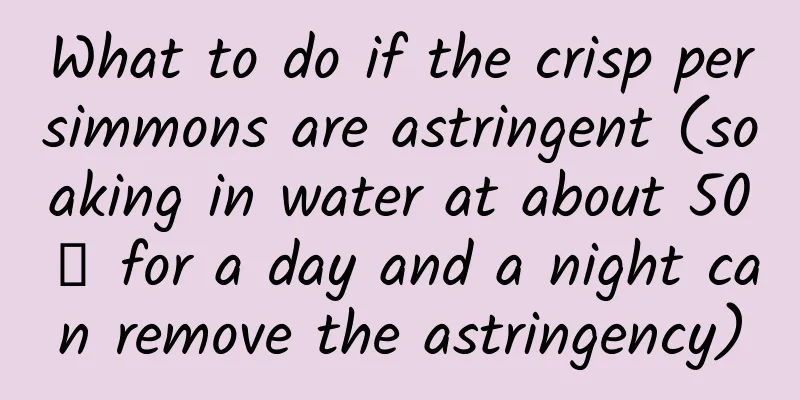What changes will happen to your body if you eat a handful of winter dates every day? Will your skin become better? Can it also prevent constipation?

|
The tastiness of winter dates is better than most fruits in autumn. They are not only crunchy but also super sweet. Once you eat the first one, you will want the second, the third, etc. However, I advise you not to eat too much! You can only eat one handful of winter jujube a day. Why? In this article, let's talk about eating winter jujube. Nutrition of winter jujube The name of winter jujube makes many people think that it is a winter fruit, but this is not the case. Winter jujube refers to late-maturing varieties with a fruit growth period of more than 120 days. In areas north of the Huaihe River and the Qinling Mountains, the fruits mature in early to mid-October. The late-maturing varieties may mature in late October and are called winter jujubes because of their late maturity. [1] Among many fruits, winter dates are quite nutritious, especially in terms of vitamin C and dietary fiber, which are excellent. Dietary fiber: According to the data in the "Chinese Food Composition Table", the insoluble dietary fiber content of winter jujube is 2.2g/100g, which is 1.3 times, 2.5 times, and 3.7 times that of apples, plums, and oranges respectively. Vitamin C: The vitamin C content of winter jujube is as high as 243mg/100g,[2] which is the best among fruits and is known as a "natural vitamin C pill". This content is higher than that of kiwi fruit, nearly 4 times, and nearly 7 times that of orange. Eating only two or three winter jujubes a day can meet the daily vitamin C needs of the general population. In addition, winter jujubes are also rich in the mineral potassium, with a content of 195 mg/100 g. [2] Although not as high as bananas, it is 2.4 times that of apples. It is a good fruit for daily potassium supplementation and is relatively friendly in controlling blood pressure. What are the benefits of eating 1 handful of winter dates every day? A handful of winter dates contains about 5 pieces, about 100 grams. If we can eat a handful every day, what health benefits will it bring to our body? ▲Photo: 1 handful of winter dates, about 100 grams Improved skin: Eating one handful of winter jujubes can provide about 243 mg of vitamin C, which can meet 243% of the average person’s daily vitamin C requirement! Vitamin C not only promotes the formation of antibodies and enhances the body’s resistance, but also promotes skin health. [3] Collagen is an important component for maintaining skin firmness and elasticity, and vitamin C plays a key role in the synthesis of collagen, which can prevent skin sagging and wrinkles. Vitamin C is an essential nutrient for beautiful skin. Prevent constipation: Winter jujube can provide us with rich dietary fiber, especially insoluble dietary fiber. The intake of insoluble dietary fiber can promote gastrointestinal mechanical movement, promote defecation, and reduce the residence time of feces in the intestines, which plays an important role in preventing constipation and maintaining intestinal health. Antioxidant ingredients: Taking in antioxidant ingredients can help us remove excess free radicals from the body and have anti-inflammatory effects. In addition to vitamin C, which is an antioxidant, winter jujube also contains flavonoids and polyphenols, and the content of these substances in the green-ripe stage is higher than that in the semi-red stage. [4] ▲From left to right: fruits in the green ripe stage, white ripe stage, red dot stage, 1/3 red stage, and half red stage Winter dates are good, but don’t show off too much Winter dates are crispy, sweet and delicious. Eating them every day is such a treat! But be careful. Although winter dates are delicious, don’t eat too many of them! Winter dates are high in sugar and calories. Eating too many of them will not only increase your blood sugar, but also make you fat. Calories: The calories in winter dates are slightly higher, at 113 kcal/100 g, [2] which is higher than bananas and jackfruits. For those who want to lose weight or control their weight, it is important to control your diet and not eat too much. If you can’t help but eat 10 or so dates at once, the calories you consume are equivalent to a bowl of steamed rice. Sugar content: The sugar content of winter jujube gradually increases with maturity. The sugar content of fully mature winter jujube is as high as over 20%, and can even reach 28%. [5] Data from the Chinese Food Composition Table show that the carbohydrate content of winter jujube is as high as 27.8%, which is nearly 2.7 times that of grapes. The soluble sugars in winter jujube mainly include fructose, glucose and sucrose. In the early stage of fruit development, fructose and glucose are mainly accumulated, while in the later stage of development, sucrose becomes the dominant sugar. [6] Sucrose is not very friendly to blood sugar, so people with high blood sugar or diabetes should eat less of it. What is the relationship between winter dates and red dates? When it comes to dates, the most familiar one is not the winter date, but the red date. Many people may be curious, what is the relationship between winter dates and red dates? Image source: unsplash.com In fact, red dates are dried fresh dates. Fresh dates include many different varieties of dates, and winter dates are one of them, including Chengwu winter dates, Lubei winter dates, Xuecheng winter dates, long strip dates, donkey nipple dates, and September green dates. Among them, Chengwu winter dates, long strip dates, donkey nipple dates, and September green dates are suitable for making dried dates, while Lubei winter dates and Xuecheng winter dates are suitable for fresh consumption. [1] Some of you may be curious: Why are fresh dates green or red and green, while dried dates are all red? In fact, the color of fresh jujubes will go through several stages during the ripening process: green ripening, white ripening, half-red ripening, and full red ripening. Current research shows that the color change of winter jujube peel is mainly the result of the combined effects of multiple pigments. The change in anthocyanin content plays a leading role in the red change process, and flavonoid pigments play an auxiliary role in coloring. [7] In other words, the jujubes are all green at first, and the skin turns red when they are fully ripe. Even if they are not completely red when picked, they will gradually turn red during the storage process. [1] The completely red fresh jujubes are dried and become the red jujubes we see today. ▲Dongzao turns red during storage After being dried, many nutrients in red dates are concentrated, such as calcium, potassium, magnesium, iron, dietary fiber, etc., but the vitamin C content is greatly lost, only 14mg/100g. [2] In addition, although red dates are very "red", don't expect to eat them to supplement iron and blood! Even though the iron content of red dates is not bad, higher than most fruits and higher than pork tenderloin, the iron it contains is non-heme iron after all, and the absorption rate is poor, only 2% to 20%. The absorption rate of heme iron is as high as 15% to 35%. In terms of iron supplementation, it is recommended to eat pork liver, duck blood, and razor clams for better results. How to preserve winter dates? It is best to refrigerate the purchased winter jujubes. The lower the temperature, the lower the respiration intensity of the winter jujubes, and they are more resistant to storage. The lower the maturity of the winter jujubes, the longer they can be stored. Studies have found that under refrigerated conditions, white-ripe winter jujubes can be stored for about 100 days; half-red winter jujubes can be stored for about 60 days; and fully red winter jujubes can be stored for about 30 days. However, long-term refrigeration of winter jujubes can easily lead to water loss and a worse taste. Therefore, some studies suggest that if you buy a lot, you can store winter jujubes at around -1°C for a better taste. [7] Moreover, there is no need to worry about winter jujube being frostbitten if stored at around -1°C. An experiment observed the effect of different temperatures on the chilling injury index of winter jujube and found that: The winter jujubes treated at -0.5℃ showed no chilling injury symptoms during the entire storage period. The winter jujubes treated at -1.5℃ showed only slight chilling injury symptoms after 90 days of storage. The chilling injury symptoms of winter jujubes treated at -3°C were the most obvious, with symptoms appearing after 30 days of storage. After 90 days of storage, the chilling injury index reached 68%, indicating the most severe chilling injury symptoms. [8] Considering that vitamin C will be lost if stored for too long, the storage time of winter dates should not exceed 45 days. Winter dates have thin skin, crispy flesh, sweet and delicious. In order to control your weight and blood sugar, you must control your diet! References [1] Xia Dunling. Study on the stability of pigments in winter jujube peel and qualitative and quantitative analysis of flavonoid components[D]. Northwest Agriculture and Forestry University, 2006. [2] Yang Yuexin. Chinese Food Composition Table 6th Edition Volume 1[M]. Peking University Medical Press, 2018 [3] Sun Changhao. Nutrition and Food Hygiene 7th Edition[M]. People's Medical Publishing House. 2017:45 [4] Li Mingyue, Shi Guochao, Zhu Jiarui, et al. Comprehensive evaluation of winter jujube fruit quality[J]. Economic Forest Research, 2021, 39(04): 256-263. [5] Sun Ailiang, He Xuan, Wang Jiazhen, Sun Mengmeng, Ren Miaochun. Relationship between sugar content variation characteristics of winter jujube fruit during maturity and fruit cracking caused by continuous rain[J]. Jiangsu Agricultural Science, 2020, 48(19): 160-164 [6] Zhang Yaruo, Tong Panpan, Liang Fengzhi, Wu Cuiyun, Wang Jiangbo. Dynamic changes in sugar component content in jujube fruit and analysis of related gene expression[J]. Journal of Jiangxi Agricultural Sciences, 2021, 33(3): 25-31 [7] He Yulong. Effects of different post-harvest treatments on storage quality and red change of winter jujube[D]. Tianjin University, 2021. [8] Liu Hui, Li Jiangkuo, Nong Shaozhuang, Zhang Ping, Kou Wenli. Effects of different temperatures on the degree of chilling injury of winter jujube[J]. Food Industry Science and Technology, 2012, 33(12): 344-348 Author: Xue Qingxin, member of Chinese Nutrition Society, registered nutritionist, health manager, public nutritionist Review | Ruan Guangfeng, Deputy Director of Kexin Food and Health Information Exchange Center |
Recommend
What should I do if my child has a bad spleen and stomach and anorexia? What causes anorexia in children?
For adults, many children's eating problems a...
How to clean the lower body after abortion?
Recently, many people have experienced unexpected...
Causes of breast tenderness before menstruation
Menstruation is a physiological phenomenon that e...
How many days after cesarean section should the gauze be removed?
More and more women choose to have a cesarean sec...
What diseases are women prone to when they are too thin?
Nowadays, thinness is considered beautiful, many ...
What is the reason for my lower abdomen to hurt and my period not coming?
What's the matter with lower abdominal pain a...
What should I do if I have a lot of acne on my face during menstruation?
Menstruation is a time when the female body under...
Why can't I get pregnant after one year of intercourse?
It is a very happy thing for a couple to conceive...
What to eat to relieve constipation in early pregnancy
Pregnant women are most prone to constipation dur...
What are the causes of vaginal pain?
Every woman wants her vagina to be healthy, which...
Can I take anti-inflammatory drugs during my period?
In fact, the probability of women suffering from ...
What season has the highest survival rate for cauliflower? What points should be paid attention to when planting cauliflower?
Cauliflower is a common vegetable in life. It is ...
Can you be jealous during confinement?
What women eat during the confinement period is p...
Canalys: US smartphone shipments fell 5% year-on-year in Q3 2023
The latest research from Canalys shows that the U...
Can I go rafting during menstruation?
Many people love drifting very much, and they can...









